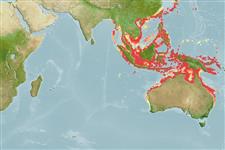>
Eupercaria/misc (Various families in series Eupercaria) >
Nemipteridae (Threadfin breams, Whiptail breams)
Etymology: Scolopsis: Name from the Greek masculine noun 'skolos' meaning 'thorn' and suffix '-opsis' (from Greek feminine n. 'opsis' meaning 'aspect', 'appearance') meaning ‘thorny appearance’ presumably referring to 'les dentelures de la préopercule, en ont aussi, et même d'épineuses, aux sous-orbitaires' mentioned by Cuvier (1814) in his designation of the genus. Name ending in -'opsis' are treated as feminine according to ICZN 1999: Article 30.1.2 (Ref. 130620).
More on author: Cuvier.
Environment: milieu / climate zone / profondeur / distribution range
Écologie
marin récifal; profondeur 2 - 50 m (Ref. 90102). Tropical; 32°N - 31°S, 90°E - 157°E (Ref. 3810)
Indo-West Pacific: eastern Indian Ocean (Andaman Sea and northwest Australia) to Papua New Guinea, north to the Ryukyu Islands, south to northeastern Australia. This species has been previously reported as Scolopsis dubiosus (a junior synonym of Scolopsis taeniopterus), or misidentified as Scolopsis temporalis.
Taille / Poids / Âge
Maturité: Lm ? range ? - ? cm
Max length : 38.0 cm TL mâle / non sexé; (Ref. 90102); common length : 18.0 cm SL mâle / non sexé; (Ref. 3810)
Épines dorsales (Total) : 10; Rayons mous dorsaux (Total) : 9; Épines anales: 3; Rayons mous anaux: 7. Head scales reaching to between anterior margin of eyes and posterior nostrils. Lower limb of preopercle scaly. Antrorse (forward-directed) suborbital spine absent. Pelvic fins long, reaching almost to level of origin of anal fin. Upper lobe of caudal fin a little longer than lower lobe. In larger specimens, lobes produced to form short filamentous extensions in larger specimens. 3 blue stripes on snout; uppermost joining eyes above nostrils. A blue stripe on preopercle behind eye. A blue chevron-shaped stripe running upwards onto opercle from below eye and bending downward towards pectoral-fin base.
Body shape (shape guide): fusiform / normal; Cross section: oval.
Occurs on sand bottoms close to reefs. Often silty habitats (Ref. 48635). Occurs solitary or in small groups. Feeds on small fishes, crustaceans, mollusks and polychaete worms (Ref. 90102). It is parasitised by the monogenean Anoplodiscus hutsonae on the pectoral fins and body surface (Ref. 124057).
Life cycle and mating behavior
Maturité | Reproduction | Frai | Œufs | Fécondité | Larves
Russell, B.C., 1990. FAO Species Catalogue. Vol. 12. Nemipterid fishes of the world. (Threadfin breams, whiptail breams, monocle breams, dwarf monocle breams, and coral breams). Family Nemipteridae. An annotated and illustrated catalogue of nemipterid species known to date. FAO Fish. Synop. 125(12):149p. Rome: FAO. (Ref. 3810)
Statut dans la liste rouge de l'IUCN (Ref. 130435: Version 2025-1)
Menace pour l'homme
Harmless
Utilisations par l'homme
Pêcheries: intérêt commercial mineur
Outils
Articles particuliers
Télécharger en XML
Sources Internet
Estimates based on models
Preferred temperature (Réf.
123201): 24.9 - 29.1, mean 28.2 °C (based on 982 cells).
Phylogenetic diversity index (Réf.
82804): PD
50 = 0.5000 [Uniqueness, from 0.5 = low to 2.0 = high].
Bayesian length-weight: a=0.01905 (0.01045 - 0.03473), b=3.03 (2.88 - 3.18), in cm total length, based on LWR estimates for this species & Genus-body shape (Ref.
93245).
Niveau trophique (Réf.
69278): 3.5 ±0.5 se; based on diet studies.
Résilience (Réf.
120179): Milieu, temps minimum de doublement de population : 1,4 à 4,4 années (Preliminary K or Fecundity.).
Fishing Vulnerability (Ref.
59153): Low to moderate vulnerability (28 of 100).
🛈
Nutrients (Ref.
124155): Calcium = 46.1 [28.8, 89.1] mg/100g; Iron = 0.601 [0.298, 1.483] mg/100g; Protein = 19 [17, 21] %; Omega3 = 0.143 [0.087, 0.238] g/100g; Selenium = 32 [19, 56] μg/100g; VitaminA = 66.9 [19.2, 186.7] μg/100g; Zinc = 1.16 [0.82, 1.66] mg/100g (wet weight);
